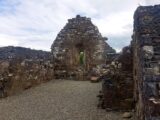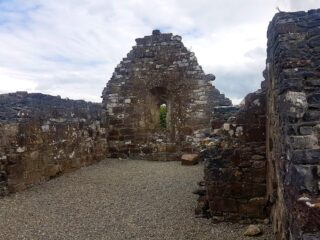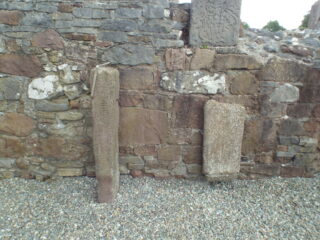Notice
Ratass Church and Ogham Stone are National Monuments in the care of the Office of Public Works
WARNING: It should be noted that these sites are unguided and a level of care and caution should be maintained during all stages of your visit. The Office Of Public Works (OPW) will not be held responsible for any damages, injuries, or losses that occur
Ratass Church and Ogham Stone
Ratass Church in the centre of Tralee town is believed to have been built on the site of an earlier ringfort built circa 500 – 600AD, hence the name Ratass, from the Irish “Ráth Mhaigh Théas”, meaning the fortress of the southern plain. The main road passing the site follows the curvature of the original ringfort.
The earliest surviving monument at the site visible today is an ogham stone thought to date to the 6th century, which has the inscription “[A]NM SILLANN MAQ VATTILLOGG” (name of Sílán son of Fáithloga). An early Christian cross slab dating 600 – 900AD is also visible to the right of the ogham stone. In the 10th century a single room church in the Irish style was built at the site in local purple sandstone. The main entrance door, and western end of the current church are the surviving parts of that original church. Later the church was remodelled in the Norman Style by extending the eastern end to divide the larger building into a nave for the congregation and a chancel for the altar. A southern doorway was also added at this time.
Ratass was the episcopal seat for the Diocese of Kerry from 1111 to 1117, when the Bishops of Kerry moved their seat of power to Ardfert Cathedral. The church fell into disuse in the 16th century, but burials in the surrounding graveyard continue to the present day. A hundred yards to the west of the church is The Republican Plot where 10 IRA Volunteers who died in the War of Independence and Civil War are buried. Amongst these are John O’Connor, from Cork who was killed in the infamous Ballyseede Massacre, and Walter Stennings (a nom-de-guerre), a former British soldier from Oxford who defected to join the IRA and was executed by the Free State Army after being captured at the battle of Clashmealcon Caves in April 1923.
Visit Historic Environment Viewer for more information on Ratass Church and Ogham Stone
Protect our Past - Click here to read about the importance of protecting our country’s unique heritage sites
This national monument is protected in accordance with the National Monuments Acts 1930 to 2014
Gallery
Nearby sites to visit
Ardfert Cathedral
A trio of medieval churches devoted to St Brendan
Approx. 9.6 km from Ratass Church and Ogham Stone
Listowel Castle
The last bastion of the Fitzmaurices
Approx. 23.7 km from Ratass Church and Ogham Stone
Ross Castle
A lakeside citadel steeped in legend
Approx. 27.1 km from Ratass Church and Ogham Stone
Scattery Island Monastic Site and Visitor Centre
Discover the History, Myth and Legend of Scattery Island
Approx. 39.9 km from Ratass Church and Ogham Stone
Desmond Castle Newcastlewest
Where sounds of medieval revelry echo around the walls
Approx. 46.9 km from Ratass Church and Ogham Stone
Ionad an Bhlascaoid – The Blasket Centre
The story of a remarkable island community
Approx. 55.3 km from Ratass Church and Ogham Stone




